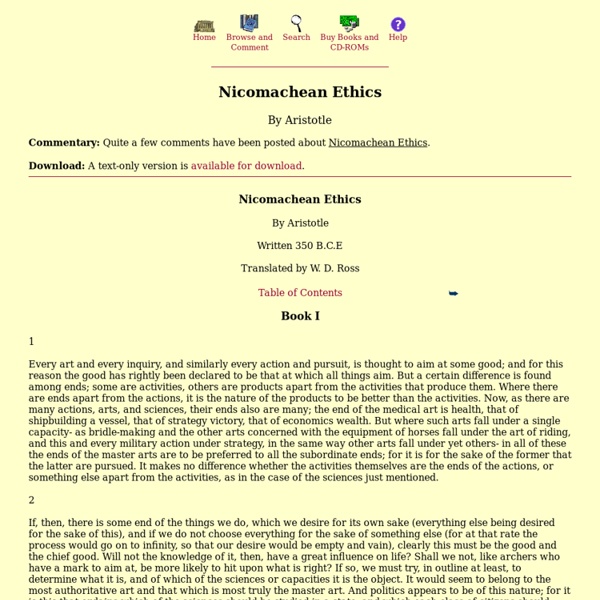Nicomachean Ethics by Aristotle
Commentary: Quite a few comments have been posted about Nicomachean Ethics. Download: A text-only version is available for download. Nicomachean EthicsBy Aristotle Written 350 B.C.E Translated by W. D. Ross 1 Every art and every inquiry, and similarly every action and pursuit, is thought to aim at some good; and for this reason the good has rightly been declared to be that at which all things aim. But a certain difference is found among ends; some are activities, others are products apart from the activities that produce them.
Partially Examined Life Podcast - Plato's Republic
Podcast: Play in new window | Download (Duration: 1:36:59 — 88.9MB) Discussing The Republic by Plato, primarily books 1 and 2. What is justice? What is the ideal type of government? In the dialogue, Socrates argues that justice is real (not just a fiction the strong make up) and that it’s not relative to who you are (in the sense that it would always be just to help your friends and hurt your enemies). Justice ends up being a matter of balancing your soul so the rational part is in control over the rest of you. The Republic is Plato’s utopia, described by analogy with justice in the individual: In the ideal state, the rational people will be in charge, and these leaders should go through rigorous conditioning and live communally (spouse sharing!) You’ll hear Wes and Dylan Casey talk about their St. Buy the book End song: “Manager,” from the 2011 New People album, Impossible Things (song written in 1997). If you enjoy the episode, please donate at least $1: by
Philosophy Bro
The Partially Examined Life Podcast - Nichomachean Ethics
Podcast: Play in new window | Download (Duration: 1:41:17 — 100.7MB) Discussing Books 1 and 2. What is virtue, and how can I eat it? Do not enjoy this episode too much, or too little, but just the right amount. Buy the book or read it online. End song: A newly recorded cover of Billie Jean by Mark Lint and the TransAmerikanishers. Please support the podcast by becoming a PEL Citizen or making a donation. by
The Partially Examined Life | A Philosophy Podcast and Philosophy Blog
Revision:Plato
TSR Wiki > Study Help > Subjects and Revision > Revision Notes > Religious Studies > Plato The Analogy of the Cave In Plato’s Republic , he illustrates his ideas about human knowledge in relation to reality and so explains the Theory of the Forms. Plato’s allegory of the Cave tells us to imagine a dark, large cave, connected to the outside world by a long passage. In the cave, with their backs to the entrance, is a row of prisoners, with their hands tied down, unable to move. Behind them is a bright fire. One day, a prisoner is released and he turns round. If he was dragged out of the cave altogether, the sun light would blind him and he would be bewildered. The Cave: The visible world, our universe. Theory of the Forms Plato used the analogy of the cave to demonstrate his Theory of Forms and is the basis of Plato’s epistemology (theory of knowledge). There is a difference between the ONE and the MANY. The Forms are interconnected and arranged as a hierarchy. Plato on the Body and Soul
Western Philosophy
Revision:Aristotle
TSR Wiki > Study Help > Subjects and Revision > Revision Notes > A Level Religious Studies Revision Notes > Aristotle Contrast between Plato Plato believed that empirical knowledge is merely opinion and that it is unreliable since the world is in a contast state of flux. However Aristotle rejected this view as he did not believe that there were 2 different realms and refused to accept that true knowledge does not belong in the empirical world. Rather he proposed the following: The Four Causes Unlike Plato Aristotle embraced the visible world of change and motion and sought all his life to describe the principles which bring about change and motion. Material Cause What the object is made of. Efficient Cause The means or agency by which a thing comes into existence (e.g a potter is the efficient cause of a bowl) Formal Cause The pattern, model or structure upon which a thing is made (e.g the formal cause of a bowl is a bowl shape) Final Cause The Soul Hierarchy of the soul The Prime Mover 1. 2. 3.
Plato Cave Revision AS
Friday, May 15, 2009 PrintEmailTweet This!Save to Favorites Candidates should be able to demonstrate knowledge and understanding of what might be represented in the Analogy of the Cave by the following: 1) the prisoners, the shadows, the cave itself, the outside world, the sun, the journey out of the cave and the return to the prisoners. Basically = (although you will need to be able to discuss critically the validity of the points being made in this analogy). The Prisoners = The ignorant masses The Shadows = The illusions we take for reality. The Cave itself = The paradigm within which we live - its all an illusion based on fallacy The outside world = Truth and reality - knowledge for Plato resides in the world of the forms. The sun = The ultimate Good. The journey out of the cave = The painful realisation that what we have taken for granted is not reality The return to the prisoners= The unwillingness of the majority to have their views challenged.
Related:
Related:



